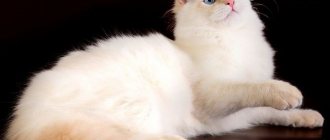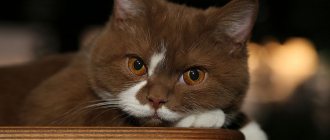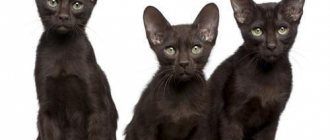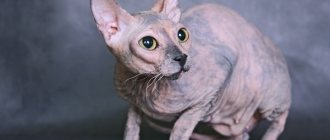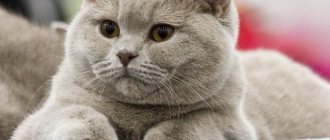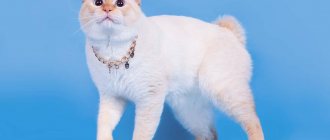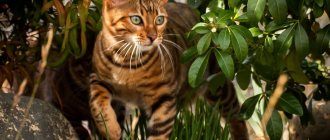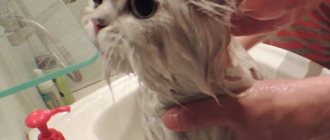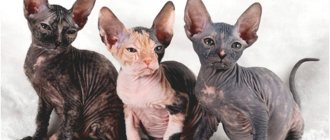Cat with round ears: Breed
Some time ago, photos of cats with rounded ears appeared on the Internet, which are very similar to cartoon mouse ears. These pictures simply blew up the Internet, users wanted to know what this new exotic breed was.
But, to the disappointment of many, it turned out that these cats are just a high-quality photoshop, and in fact such a breed does not exist.
There are only cats with more or less rounded ears. These include:
- Persian cats.
- Exotics (similar to Persians, but larger eyes).
- American Curls. Their ears bend back and look round.
To enlarge the picture, click on it
Gorgeous cat breeds with big ears
Cats are different: black, white and even red, fluffy and hairless, royally beautiful and simply cute.
But the world does not stand still, and geneticists, together with breeders, are developing more and more new breeds. So today we will talk about eared animals - pets with huge ears. According to rumors, they are now at the peak of popularity among cat lovers.
Why are big ears needed?
Whether or not to classify a breed as large-eared is a subjective question. After all, to the eye, a cat may seem incredibly long-eared, but when you compare the proportions of its body, it will turn out to be quite ordinary and standard. In addition, thin pets' ears always seem larger than they actually are.
According to statistics, in nature large ears are found in animals living in the tropics or desert. It's all about the hot climate. After all, it is through the huge external hearing organs, strewn with hundreds of capillaries, that the cat gives off excess heat and thus regulates natural heat exchange.
By the way, contrary to popular belief, the size of the ears does not affect hearing acuity in any way.
And yet, what kind of cat breeds with big ears are these? Usually these are oriental beauties, but there are also those that were bred purposefully.
Siamese
Siamese cats have a capricious character.
Siamese cats can be put at the top of the list. In addition to their unusually sized ears, they have a long, lean build, a thin neck, and elongated limbs. They have a short fur coat. The color is a characteristic bicolor. Almost all representatives of the breed are distinguished by their wayward character and independence.
Abyssinians
Descended from the famous African cat. They have an unusual exotic color called “safari”. They are of medium size, but have impressive muscles. The ears are naturally large and cone-shaped. Just like previous pets, they have a complex disposition.
Havanese
Another native of the wild fauna. They are somewhat reminiscent of Siamese, but the main color is cigar, which, in principle, served as the basis for the name of these exotic cats.
Devon Rex
Due to the shape and size of their large and wide ears, they are often compared to alien creatures. Representatives of the breed have a lean physique, and the head resembles an elongated ellipse. Sociable and incredibly friendly pets.
Kanaani
This is a real predator not only in its disposition, but also in its protective wild color. The cat is large and massive, the ears are large and pointed at the ends. Recognized as a true hunter.
Cornish Rex
English aristocrats, who are often called astrakhan because of the structure of the coat, which forms fancy curls.
Maine Coons
Well, the Maine Coon's ears have beautiful tufts.
One of the largest pets. But despite their impressive size, they are distinguished by a soft, calm and calm character - sort of couch potatoes with an excellent appetite. They have a wide range of colors. The ears are not only large, but also decorated with cute tassels at the tips.
Orientals
It was their blood that formed the basis for the creation of many modern cat breeds. They have elongated proportions, short hair and two types of color: tabby and solid (solid).
Pudelcat
An unusual and very young breed. So named for its slight resemblance to a poodle. The ears are not only large, but also slightly drooping. The entire upper part of the body is covered with small curls; the belly is usually not distinguished by increased hairiness.
Dune cat
A wild baby with huge ears and a sandy coloration. Lives in deserts and semi-deserts, and is not particularly accustomed to life at home.
Savannah
Another native of the wild. Appeared as a result of crossing the wild serval and the meek domestic cat. It has a beautiful spotted color, is huge for pets, and has good adaptive properties.
Serengeti
Obtained by crossing Benagles and Orientals, it looks very similar to the Savannah, but is much smaller. The ears are so large that they seem to take up most of the head.
Sphinxes, including Canadian, Don, St. Petersburg
The Canadian Sphynx is a hairless cat with huge ears.
Bald miracle with a velvet body. It has a long body, and the ears are somewhat reminiscent of Siamese. Many consider bald heads to be hypoallergenic, but before bringing this miracle into your home, it doesn’t hurt to take a compatibility test.
The Canadian Sphynx is another representative of the hairless cat breeds with large, bat-like ears.
Russian pebbles (Don and St. Petersburg sphinxes) are also famous not only for their lack of hair, but also for the outstanding size of their locator ears.
This group of cats needs careful and almost daily skin care, proper nutrition and a warm microclimate.
Toyger
Miniature tiger with a striped coat. A very active and friendly animal, suitable for home keeping.
Levkoy
Bred in Ukraine. This is a hairless cat with drooping ears, reminiscent of the petals of the flower of the same name.
Each cat is beautiful in its own way, it doesn’t matter what size its ears are or how it looks from the outside. Any animal, regardless of breed, needs affection and kind treatment. Love your pets and they will love you back.
Kitties
drollanimals.ru
Cat breed with round ears: Wild houses
In addition to true domestic cats, hybrids of domestic and wild cats: servals and savannahs have rounded ears. These exotic representatives are no longer so rarely seen in cities as pets.
We must understand that their character and needs are closer to those of their ancient ancestors , who bloodthirstyly dealt with their victims. That's why cats and predators.
It is also worth considering that it is not recommended to keep such pets in a one-room apartment.
They need a separate corner or even a room. In addition to the high price for such rare cats, the peculiarity is that they need more food than an ordinary domestic cat.
To enlarge the picture, click on it
Contrary to many opinions, the diet should not consist of proteins alone. The food must have a balance of fats, carbohydrates, proteins and minerals.
The cat must be provided with exercise. Walk with her on the street or create a play complex with the ability to sharpen her claws, jump and run. Otherwise, the fluffy beauty will begin to take out her needs on curtains, furniture, wallpaper and other things of the owner.
Regarding health, the recommendations are the same as for ordinary cats. Regular vaccinations and dewormings.
A medical examination is also required once a year. If you do not plan to breed, then it is better to sterilize the cat in order to avoid health problems, active manifestation of rutting and marks.
Watch the video: Amazing pet with mouse ears - American Curl
If you liked our article, read other materials about cat health on the Guardian of Purity website. Dog owners are also welcome! To do this, go to the appropriate section.
The resource also publishes information about cleaning apartments, offices, industrial premises, home and specialized household appliances, washing and stain removal.
Share articles by clicking on the buttons of your favorite social networks. Stay with us!
Cat breeds with a flattened face
There are several brachycephalic breeds, differing in the degree of flattening of the head, standards of appearance, living conditions and character. Let's look at each of the breeds below.
Persian cat
This breed was one of the most popular in the world a couple of decades ago. Nowadays, interest in Persians has diminished, but representatives of this breed still have many fans. They are medium to large sized cats with powerful paws and long, thin, easily tangled hair. According to the degree of flatness of the muzzle, classic and extreme subspecies are distinguished. In classic Persians, the front part of the head is slightly elongated, while in extreme Persians, it is almost in the same plane as the eyes. Persians have a calm, domestic character and get along well with children, but they are much more dependent on their owners than cats of other breeds.
We recommend that you read the full article about Persian cats.
Himalayan cat
The Himalayan cat appeared in the 50s of the twentieth century in the USA as a result of crossing Siamese and Persian cats. Subsequently, only individuals with a pronounced Siamese color were allowed to breed, which allowed a breed with a predominant Persian exterior, but Siamese coloring and bright blue eyes.
Later in Great Britain, color-point dogs were bred from Persian and Himalayan breeds. They were distinguished from the Himalayans by their greater color intensity and elongated muzzle.
Now the independence of the Himalayan breed is not recognized by all associations. Some of them register Himalayan cats as Persians.
These cats will appeal to quiet and calm people. They do not like noisy places and dangerous games, but at the same time they treat children well and are very patient.
Read the full article about Himalayan cats.
Exocot
The exotic shorthair was bred by American breeders by accident. Scientists wanted to get a long-haired version of the American Shorthair breed and crossed animals of this breed with Persians, but the result was a Persian cat with short hair.
Most exotics are extreme cats with big eyes and soft, velvety fur. They are characterized by short strong legs, a squat body, developed muscles and a convex forehead. Due to their short coat length, exotic cats are much easier to care for than Persians.
Scottish fold cat
Scottish Fold cats, or, as this breed is also called, Scottish Fold, are cats of medium build (up to 6 kg) with a powerful body, a round head proportional to the body and hanging triangular ears that visually round the head even more. They have a more elongated muzzle than exotics. Among cat lovers, “Scots” have gained popularity due to the unusual shape of their ears, the constantly surprised expression of their eyes, their docile nature and devotion to their owner.
In some animals, upon reaching adulthood, the ears remain straight. They are classified as another, closely related breed - the Scottish Straight.
British shorthair cat
"British" belong to the category of brachycephals with short hair. These are strong, intellectually developed animals larger than the average cat. English legend says that the British Shorthair is descended from the Cheshire cat.
Although short in length, the British coat is quite thick. The most popular color of the British cat is blue with a silver tint. Cats with this color usually have amber eyes. Striped colors (tabby) and color point are also common.
Read the detailed article - British Shorthair cat.
Wild cat breeds with flattened faces
Among wild cats, brachycephaly is characteristic only of manul cats, hunter cats native to Central Asia. This animal is the size of a domestic cat, has a massive, squat body and thick tabby fur (necessary for camouflage). The flat shape of the muzzle helps the Pallas cat successfully hunt and carry prey: the flattened shape of the head allows the animal to breathe with the carcass in its teeth, and stronger jaws allow it to hold it more firmly.
The Pallas's cat is listed in the Red Book of Russia under category 3 (“rare species”).
Causes of irregularly shaped ears in cats
The cause of abnormal ear structure is a mutation gene, and it is different for each breed. For example:
- Scottish Fold gene is a dominant lop ear gene with partial penetrance. Representatives of pets with this mutation have ears that “look” forward. Moreover, the degree of fit of the ears varies. The gene for fold-eared breeds is also associated with limb defects: in parallel with “wrong” ears, changes occur in the cat’s skeleton. Because of this, breeders stopped crossing two individuals of Scottish Folds with each other, thereby eliminating animal health problems.
- American Curl gene. With this mutation, the cat’s ear begins to “curl” towards the upper tip. The ear can be turned up to 180 degrees. This gene does not have a negative effect on the development of the cat and its health.
- Round ears. As a result of the predominance of the mutating gene, the animal has not the traditional triangular shape of the ears, but a round one. This “defect” was first discovered in pets in Italy, and later in America.
Cat breeds with abnormal ear structure
There are eight breeds of cats in which the structure of the ears differs from the usual standard shape. These breeds include:
- Scottish fold. Today this breed is the most common. It was developed in the 20th century in Scotland. The appearance of cats is quite unusual; they resemble small owlets due to their curled ears and large eyes. Due to a mutation, Scottish cats have two types of ears: forward-curved (called Scottish Folds) and straight (Scottish Straights). For many years, geneticists prohibited the breeding of this breed due to the accompanying health problems, but the problem was solved. During breeding, Scottish Folds were crossed only with Scottish Straights. As a result of such mixing, the gene for lop ears remained, and hereditary diseases disappeared.
- Highlander is a cat breed bred in America in the nineties of the twentieth century. Breeders crossed the jungle curl and the desert lynx. The result was a cat with a beautiful spotted color, a small tail and curled ears. This breed was officially recognized by the International Cat Association in May 2008. Fans of unusual breeds are happy to purchase Highlanders.
- The American Curl is a relatively new breed, originally from the USA. Pets have an interesting ear structure; they curl outward. It is noteworthy that kittens are born with straight ears, but after a week they begin to curl up. The American Curl was recognized only in 1983. At the same time, standards for this breed and a breeding plan were developed. In the late 90s, Roy Robinson, a British breeder, wrote an article stating that, apart from curled ears, no genetic disorders were observed in bred Curl kittens. And unlike other breeds that take decades to be recognized, the American Curl has been accepted by the International Cat Association.
- Peterbald (St. Petersburg Sphynx) is a Russian breed, bred in 1994 by Olga Mironova. A Russian felinologist crossed an oriental cat and a Don Sphynx. The result was a hairless pet with big ears. The beautiful St. Petersburg Sphynx received recognition from the Breeding Felinological Federation in 1996. At the end of the twentieth century, Peterbald gained worldwide recognition. To date, crossbreeding work continues.
- Ukrainian Levkoy - the breed was bred in 2004 by felinologist E.V. Biryukova. She crossed the Don Sphynx with the Scottish Fold. In 2007, a nursery for Levkoys was opened in Russia. A distinctive feature of the breed is the appearance of the ears, which are located high and slightly curved towards the head. This breed is becoming increasingly popular in the modern world.
- The Elf is a breed native to North America. In 2006, this breed was developed by two breeders Kristen Lead and Karen Nelson. They crossed the Canadian Sphynx and the American Curl. The result was a beautiful hairless cat with large curved ears, like an elf. Hence the name. Pets have good health and endurance. Since selection work is still ongoing, the breed has not been officially recognized by any phenological organization.
- Oriental cats were bred by American breeders in the 60s. By crossing a Balinese cat and an Oriental shorthair, breeders were able to create this amazing cat. For the first time, the elegant beauty was presented at competitions in 1977 as an independent breed. But long-eared cats were officially recognized in 1997 by the GCCF association. The Oriental cat is similar to the Siamese breed, only its ears are much larger.
- Kinkalow - in 1997, American breeder Terry Harris crossed an American Curl with a Munchkin. As a result of this crossing, kittens were born with two different mutations - short legs and curved ears, a long tail and a massive body. In 2008, the Kinkaloo was recognized by the Dwarf Cat Association. Today, representatives of this breed can be seen mainly in America.
Each of the above breeds has its own advantages and disadvantages. But they all have one thing in common - the “wrong” structure of the ears. Some people are attracted and impressed by this feature, while others are repulsed. In any case, cats, despite their body structure, remain affectionate and gentle favorites for their owners.
Mouse cat: characteristics of the cat’s appearance and behavior of cat breeds with large ears
It’s impossible not to notice the funny big-eared cats - it’s probably been said about them: “Ears stick out everywhere.” Huge ears make cat faces especially expressive and memorable. However, this is not just a whim of nature; such ears perform their functions.
Why does a cat have big ears?
A very common misconception is that the larger the ears a cat has, the better it can hear. Nothing of the kind: the size of the auricle in no way affects the acuity of a cat's hearing. Cats with small ears have just as good hearing as cats with large ears.
Big ears on a cat are beautiful
This anatomical feature has a purely utilitarian explanation - it is a unique and quite effective cooling system. Initially, it is inherent in those cat breeds that are of eastern or southern origin - the regulation of heat exchange is especially important for them.
A huge number of capillaries are concentrated in the auricle. Passing through these vessels, the blood is cooled to the optimal temperature, which helps the cat avoid unnecessary overheating. In hot weather, blood circulation occurs faster, in cool weather - slower. That's the whole secret.
Large ears help a cat regulate its temperature balance
Eared cats look funny and unusual. Breeders cultivate this feature solely for the sake of breed marketing - exotic appearance stimulates sales. Therefore, it is difficult to say that super ears are so necessary for modern cats to live a normal life. On the other hand, this doesn’t really bother them.
Cat breeds with big ears
Everything in nature is relative, and so is the size of the ears. But these cat “locators” cannot be hidden in any way - huge ears stick out triumphantly above the narrow triangular muzzle. It is no coincidence that representatives of large-eared breeds are called “mouse cats.”
Photo gallery: variety of long-eared cats
Devon Rex is a fidget with wavy fur Havana cat does not like to be left alone Kanaani is a very rare and young breed bred in Israel Cornish Rex has a “figure” similar to a curly Italian greyhound Oriental cats come from Southeast Asia Desert dune cat is a wild animal , unadapted to home keeping The poodlecat resembles the hair of a curly poodle Serengeti - a product of crossing a Bengal and an oriental cat Savannah - a smaller copy of a wild serval Sphinx - a charming “bald face” with large ears Toyger - a small domestic tiger Ukrainian Levkoy - an “alien” in the cat environment Angora cat independent, willful, but very attached to the owner Somalia - a long-haired version of the Abyssinian cat Abyssinian - one of the most ancient breeds of cats Maine Coon - a large cat with large ears Siamese cat - an elegant but capricious beauty
Abyssinian cat
The breed has very ancient roots and African origins; it is also called Algerian or Ethiopian. Cats of American and European selection are not significant, but still differ from each other. Abyssinians are very beautiful, elegant and graceful. Shiny short fur emphasizes the perfect shape of her body. Main colors:
- wild;
- sorrel;
- blue;
- beige.
Abyssinian cat is an ideal hunter
The Abyssinian cat’s favorite pastime is to observe the territory entrusted to it from a high point. She is sociable and gets along well with other pets, even finding a common language with dogs. This breed has a lot of undeniable advantages:
- high intelligence and quick wit;
- lack of aggression;
- devotion to the owner;
- easy, cheerful disposition.
If you are a very busy person, it is better not to get a cat of this breed. The attention of a beloved owner is very important for the Abyssinian. Alone, she will become bored, suffer and may even get sick.
Kanaani (Canaani)
A young experimental breed obtained by crossing a wild steppe Libyan cat with domestic outbred individuals. During the formation of the breed, the blood of Oriental, Abyssinian and Bengal cats was also infused. As a result, a very interesting animal was obtained, the hind legs of which are significantly longer than the front ones, which allows the Kanaani to run very fast and jump high. This is a strong and resilient cat; regular physical activity and mandatory walking on a leash are vital for her.
Kanaani - the fruit of love between wild and domestic cats
From her ancestors, Kanaani received an exclusive set of breed qualities, including:
- freedom-loving and independent disposition;
- unpretentiousness in maintenance and nutrition;
- stable nervous system;
- sociability and need for affection.
Kanaani received its first standard only in 2000 and has continued to develop actively since then. Breeding nurseries exist only in Israel, where this rare breed was bred, and in Germany.
Havana
A very striking, sophisticated and elegant cat with sparkling fur the color of dark chocolate. She has incredibly expressive eyes and a beautifully muscular body. Due to its well-developed muscles, this small cat weighs more than it might seem at first glance - from three to five kilograms. Even a Havana Brown's mustache must be brown, otherwise she will be disqualified from the show.
Havana Brown - a cat from the Swiss mountains
There are very few purebred Havanas in the world, so the cost of a kitten cannot be less than a thousand dollars. However, the happy owners of these unique animals are sure: perfection cannot be cheap. And indeed, in addition to its incredibly beautiful appearance, Havana is also endowed with an amazing character - a whole bunch of wonderful qualities:
- absolutely not aggressive;
- active and playful;
- capable of performing circus tricks;
- She is touchingly attached to her owner and cannot stand long separation from him.
Obtaining animals with a stable dark brown color turned out to be a difficult task - it even required a special climate. The new breed was developed in Switzerland, in a cool mountainous area, and at first the Havana was usually called that - a cat from the Swiss mountains. Although the official homeland of the exotic breed is Great Britain.
Video: cat the color of a Havana cigar
Devon Rex
Huge ears are the first thing that catches your eye in a cat of this breed. The Devon Rex is an extraordinary cat of English origin with delicate curly hair. Such breed characteristics are the result of a genetic mutation. Fancy wool is hypoallergenic and can come in a wide variety of colors: the standard does not limit them. These are not too large, but very mobile and flexible animals.
The huge ears and curly hair of the Devon Rex are the result of a mutation
Devon Rexes strive to establish the closest possible contact with their owner and for this purpose they constantly climb onto his shoulders, rub his neck, and look into his eyes. This amazing look is impossible to forget! However, like many properties of this strange breed:
- choosing one master and subordinating only to him;
- creativity in games and tricks;
- incredible jumping ability;
- quick adaptation in unfamiliar places;
- Friendly to children, dogs and new people.
Numerous fans of Devon Rex call their pets hybrids of a cat, a dog and a monkey - and there is something true in this. There is too much unusual in this eared and big-eyed cat: appearance, character, and behavior.
Video: Devon Rex - a cat that looks like an elf
Cornish Rex
The coat of this cat is practically devoid of guard hair, and the soft short undercoat forms a mass of small waves and curls along the body, the structure most reminiscent of astrakhan fur. Like Devons, Cornish dogs are selected in England, but these are completely independent breeds, despite all their external similarities. In everyday life, Cornish Rex cats are modest and unpretentious, rarely get sick, and reproduce without problems.
The main thing about the Cornish Rex is its coat
The breed standard allows any variant of coat color, but is very strict regarding its quality. Representatives of this breed are unique in many ways:
- have very acute hearing;
- temperamental and very emotional;
- excellent at climbing trees, curtains and furniture;
- wagging their tail like dogs.
Cornish owners should remember two important points: their pets are terrible gluttons, and they should not be overfed under any circumstances, and they are also afraid of the cold and especially drafts.
Savannah
A very interesting animal - the fruit of a strange love between a wild African serval and an ordinary domestic purr. The following breeds were used in hybridization:
- ocicat;
- Egyptian Mau;
- Bengal cat;
- Oriental Shorthair.
What happened as a result? Outwardly, this hybrid is a clone of a wild animal, but has the gentle disposition of an accommodating pussy. Quite a large animal with an exotic spotted color and incredibly graceful plasticity. Some individuals reach 60 cm at the withers and weigh 15 kg.
Savannah - wild on the outside, kind on the inside
Savannah differs from the usual breeds of domestic cats in a number of features:
- late maturation - the animal is fully formed only by the age of three;
- high adaptability to any living conditions;
- good getting along with family members and pets;
- developed intelligence and quick reactions;
- unconditional loyalty to one master.
Savannah is a young, but today the most expensive cat breed in the world. Breeders are working on its development and improvement, periodically adding fresh serval blood - the higher the percentage of “wild” blood, the more expensive the cat.
Sphinx
A fairly popular breed of hairless cats lately. Among the Sphynxes there are several independent breeds:
- Canadian Sphynx;
- Don Sphynx (Russian hairless);
- Peterbald (Petersburg Sphynx).
Canadian Sphynxes are the most stable breed, with half a century of “experience”, recognized by all authoritative international felinological organizations. The build of these cats is perfect: when they are still, they resemble figurines, and when they move they show amazing plasticity and grace. The Sphynx's body is hot and folded, it is not completely hairless - some of its parts are covered with soft short down.
The Sphinx, if you look closely at it, is not exactly “bald”
Sphynx owners adore their pets not so much for their exclusive appearance, but for their ideal character:
- amazing love and need for affection;
- the desire to always be close to the owner;
- common sense and patience;
- lack of aggression and jealousy towards other pets.
Already at the first meeting, the Canadian Sphynx will pleasantly surprise you with its intelligence and intelligence. It is no coincidence that his intelligence is assessed as comparable to the level of a three-year-old child - and the cat “talks” about the same amount, only in its own language.
Siamese cat
For her beauty and grace, the owners of this blue-eyed beauty are ready to forgive her a lot: both her quarrelsome character and fastidiousness in her content. Siamese cats are one of the most ancient and well-known breeds - they have remained unchanged for more than five hundred years. Their memorable color is associated with such an interesting, genetically fixed phenomenon as acromelanism - more pigment is produced in cold parts of the body than in warm parts.
Looking at a Siamese, you immediately understand how the temperature balance of her body is distributed - in any case, her huge cooler ears are intensely painted a dark chocolate color.
The Siamese cat is lazy, capricious, but charming
The Siamese cat has collected a whole collection of contrasts - seemingly completely incompatible qualities:
- lazy, but not averse to playing;
- arrogant, but needs attention;
- very smart, but not trainable;
- sociable, but likes to be alone.
Siamese kittens are born completely white, and only by six months as they grow older do their true colors appear. At the same time, the character of the Siamese gradually develops - she is vindictive and shows aggression only in response to old grievances. So it is better to raise this cat with love and attention.
Video: all about the beauty Siamese
Somalia
As often happens in breeding work, breeding marriage served as the “raw material” for creating a new breed. Breeders of Abyssinian cats had to cull from time to time fluffy kittens, unknown how they appeared in normal short-haired litters. The “removed ones” turned out to be so beautiful that it was a pity and a shame to reject them. Enthusiasts took up PR and breeding work - this is how a relatively young breed emerged from the long-haired Abyssinians - the Somali.
Somalia always feels like a queen
These majestic, very spectacular animals are endowed with an absolutely wonderful character:
- calm and balanced;
- adore children;
- playful and affectionate;
- are highly trainable.
Somali cats are exotic and rare in our open spaces, and this promises good prospects for the breed. Because the well-deserved wide recognition received by the Somali beauty around the world will definitely reach us.
Serengeti
Despite its wild appearance and exotic name, the Serengeti is quite a domestic cat with a bright and interesting character. But it’s still very rare and expensive. The Serengeti appeared as a result of crossing a Bengal cat and an Oriental shorthair (oriental) breed, from which it received its “wild” spotting. There are no servals in the ancestors of the breed - but the resemblance to them is amazing!
Serengeti - a domestic cat that looks like a wild beast
An elegant, athletic cat has a strong, muscular body and moves very beautifully, waving its tail, the tip of which is always painted black. The Serengeti also has “model” legs - the longest of all domestic cat breeds. Today, no more than a thousand of these charismatic animals live throughout the world, and if you are lucky enough to become the owner of one of them, pay special attention to the following traits of your pet:
- These are chattering cats - talk to them more;
- they are overly stubborn - to distract the cat from small dirty tricks, provide it with toys;
- have a fighting nature - the Serengeti fearlessly rushes into a fight, even when the opponent is much stronger;
- strive for leadership always and in everything - gently correct your pet if he is wrong.
The Serengeti are famous for their excellent health and strong immunity, but they often suffer from urolithiasis. Breeders are working to minimize bad heredity, but so far, unfortunately, it largely determines the short life expectancy of these cats - only an average of ten years.
Video: talkative and inquisitive Serengeti
Features of care
When caring for big-eared cats, you must first take into account the characteristics of the breed to which they belong. But proper ear care is extremely important for all “mouse cats” - after all, the larger the ears, the more problems can arise with them.
Each breed has its own maintenance nuances, but ear care is the same for all cats.
Ear hygiene
Cleanliness, as they say, is the key to health. Timely and high-quality hygiene of cat ears is the prevention of infection, and, consequently, various serious diseases. Check your pet's ears regularly and contact your veterinarian immediately if the following symptoms appear:
- redness and itching;
- swelling;
- unpleasant odor;
- painful sensations.
If you have any problems with your ears, contact your veterinarian.
For preventive care at home, you should choose a ready-made product for this purpose - the choice of ear drops is quite large. The use of alcohol, peroxide and other homemade products can lead to irritation and even burn the delicate surface of the ear.
Contamination and the occurrence of inflammatory processes can be caused by hairs growing too densely inside the ear - they must be removed, but only very carefully so as not to cause pain and discomfort to the animal.
The cat's ear should be clean and free of excess hairs.
Before proceeding directly to the procedure of cleaning the ears, it is recommended to do a light massage - lightly rub and knead the ears for five to ten seconds. Then give the cat a couple of minutes to shake its head - this will cause the softened wax to come out of the ear canals. Wipe it off with cotton pads or swabs soaked in ear cleaning fluid, but be sure to use different swabs for your ears. Try not to go deep into the ear canal.
Ear cleaning is a regular and responsible process.
Video: “pockets” on a cat’s ears
Reviews from Ushastika owners
A charming big-eared fluffy will decorate your home and bring harmony and joy to it. And the biggest problem will be the problem of choice - which eared breed to choose. Everyone is good - both smart and beautiful; Well, everyone’s ears are beyond competition!
- Author: Irina Nezhigay
prohvost.club
American Curl
This breed of cats with round ears is now at the peak of popularity; besides, the pets themselves have not only an unusual appearance, but also a friendly disposition, they are very sociable, devoted to their owner, and play with pleasure. Distinctive features of the appearance of these animals are as follows :
- Elegant graceful physique.
- Flexible long tail (its length matches the size of the body).
- The average weight is small - 5-7 kg (males), 4-5 kg (females).
- The coat can be either long or short, with long-haired Curls being the most popular among breeders.
But the most striking detail of the pets’ appearance is their rounded, curved ears, the unusual shape of which is explained by a mutation of the hard ear cartilage. In the photo you can see that the inclination of the shell is individual for each cat, it can be 180°, or it can have a more modest value - 90°. A characteristic feature of the breed is that the round tip should not exceed 1/3 of the ear. One of the difficulties faced by pet owners is the fragility of the ear cartilage, so you need to be very careful with your pet.
Cat breeds with ear defects [photo + list of breeds]
People strive to stand out from the crowd - original clothes, unusual gadgets, even a cat “with a twist.” Breeders try to present as many breeds as possible with some feature; cats with inverted or concave ears are especially popular. You will learn about some of them from our article.
List of cat breeds with ear defects
- American Curl;
- Scottish fold;
- Highland Fold;
- Peterbald;
- Ukrainian Levkoy;
- oriental cat;
- munchkin;
- poodlecat;
- elf;
- Kinkaloe;
- Dwelf.
Kittens of these breeds are in demand - everyone wants an unusual cat. But it is important to understand that these are breeds with ear defects, so the pet will require special attention. There may be some characteristic diseases, so before you decide to buy, you need to weigh everything.
American Curl
Bred in America. These are cats with ears folded back, which gives the face a slightly surprised look. Very similar to owls. Kittens are born with normal ears, but after a week they turn up.
The gene for curled ears is unique; there is no breed with similar characteristics (unless the Curl is involved in breeding, of course). The history of American Curls began with one black cat found on the street.
Price - about 25,000 rubles.
Scottish Fold
Another cat with round ears is called the Scottish Fold. This is a very cheerful and friendly animal that does not require special care. The characteristics of the breed are :
- Medium-sized body with thick, pleasant-to-touch, plush-like fur.
- The head has a rounded muzzle and round whisker pads.
- The wide-set ears have an unusual shape - their upper part is bent so that it hides the pinna.
- Round big eyes. We allow them to have different colors, but they must match the color of their coat.
- The nose is wide.
- The tail is medium in size, tapering towards the end.
The round shape of the ears is the result of a genetic mutation in the simplest domestic cat. Animals with good care can live up to 15 years, but owners should remember two weak points of the breed. These are diseases of the joints (the tail is especially dangerous) and the heart. Cats are also prone to overeating.
Ukrainian Levkoy
Representatives of the breed have rounder ears than the Scots. In the photographs you can see that their appearance is very unusual: they have large round ears and a complete absence of hair.
To develop the breed, Don Sphynxes, Scottish Folds, Orientals, Peterbalds and domestic cats were used. Due to such a rich list of ancestors, the Ukrainian Levkoy got its original appearance. The name of the breed was given by the gillyflower, which is distinguished by its external resemblance to the downward curved small round ears of such cats. The animal's traits are :
- Muscular body of medium size. Weight – about 5 kg.
- The eyes are large, almond-shaped. Preferred colors are blue, green.
- The skin is covered with numerous folds and is always hot.
- Ears with rounded tips are set high.
They are distinguished by a pliable disposition, sociable, intelligent and quick-witted, devoted to their owner and very affectionate.
Chausie
Photo: Instagram: @fixzoo
This unique breed was bred quite recently - in the 90s of the last century by crossing wild and domestic cats. The large ears of its representatives are located at a slight angle. Outwardly, the chausie resembles a wild representative of the jungle, and its disposition differs little. She prefers solitary games in the lap of nature or, at worst, in an apartment, to the caresses of her owner.
Highlander
A new breed, the Highlander, also has round ears. These are very unusual animals of an exotic species, which also have the name “mountain lynx”. However, among the ancestors of these cats there were no dangerous predators; their ears are slightly curved back, and their muzzle in its expression resembles a trot. The distinctive features of the breed are:
- Powerful muscular body.
- Short tail.
- The eyes are large and round in shape.
- The acceptable colors are varied, the standard recognizes the presence of 1-2 colors, as well as color point colors.
Cats with round ears are diverse, among them there are long-haired and short-haired, large, medium and small in size, but they all look bright, unusual and attractive.
All cat breeds
Cats have been known to mankind for at least 10,000 years; they have been highly valued by people at all times not only for their ability to catch rodents (catching mice is especially important at home), but also for their innate ability to bestow people with their affection.
10,000 years of love and benefit
Scientists have found that all modern cat breeds come from the steppe cat, which was domesticated by humans. This happened at different times in different parts of the world, so data may vary depending on the region. However, despite the fact that domestication occurred on average 10,000 years ago, cats have almost completely retained the ability to go wild. And this is combined with the enormous love for a person that they are able to show.
Features of care
When caring for big-eared cats, you must first take into account the characteristics of the breed to which they belong. But proper ear care is extremely important for all “mouse cats” - after all, the larger the ears, the more problems can arise with them.
We recommend reading: 10 most beautiful dog breeds
Each breed has its own maintenance nuances, but ear care is the same for all cats.
Ear hygiene
Cleanliness, as they say, is the key to health. Timely and high-quality hygiene of cat ears is the prevention of infection, and, consequently, various serious diseases. Check your pet's ears regularly and contact your veterinarian immediately if the following symptoms appear:
- redness and itching;
- swelling;
- unpleasant odor;
- painful sensations.
If you have any problems with your ears, contact your veterinarian.
For preventive care at home, you should choose a ready-made product for this purpose - the choice of ear drops is quite large. The use of alcohol, peroxide and other homemade products can lead to irritation and even burn the delicate surface of the ear.
Contamination and the occurrence of inflammatory processes can be caused by hairs growing too densely inside the ear - they must be removed, but only very carefully so as not to cause pain and discomfort to the animal.
The cat's ear should be clean and free of excess hairs.
Before proceeding directly to the procedure of cleaning the ears, it is recommended to do a light massage - lightly rub and knead the ears for five to ten seconds. Then give the cat a couple of minutes to shake its head - this will cause the softened wax to come out of the ear canals. Wipe it with cotton pads or swabs soaked in ear cleaning fluid, but be sure to use different swabs for your ears. Try not to go deep into the ear canal.
Ear cleaning is a regular and responsible process.
